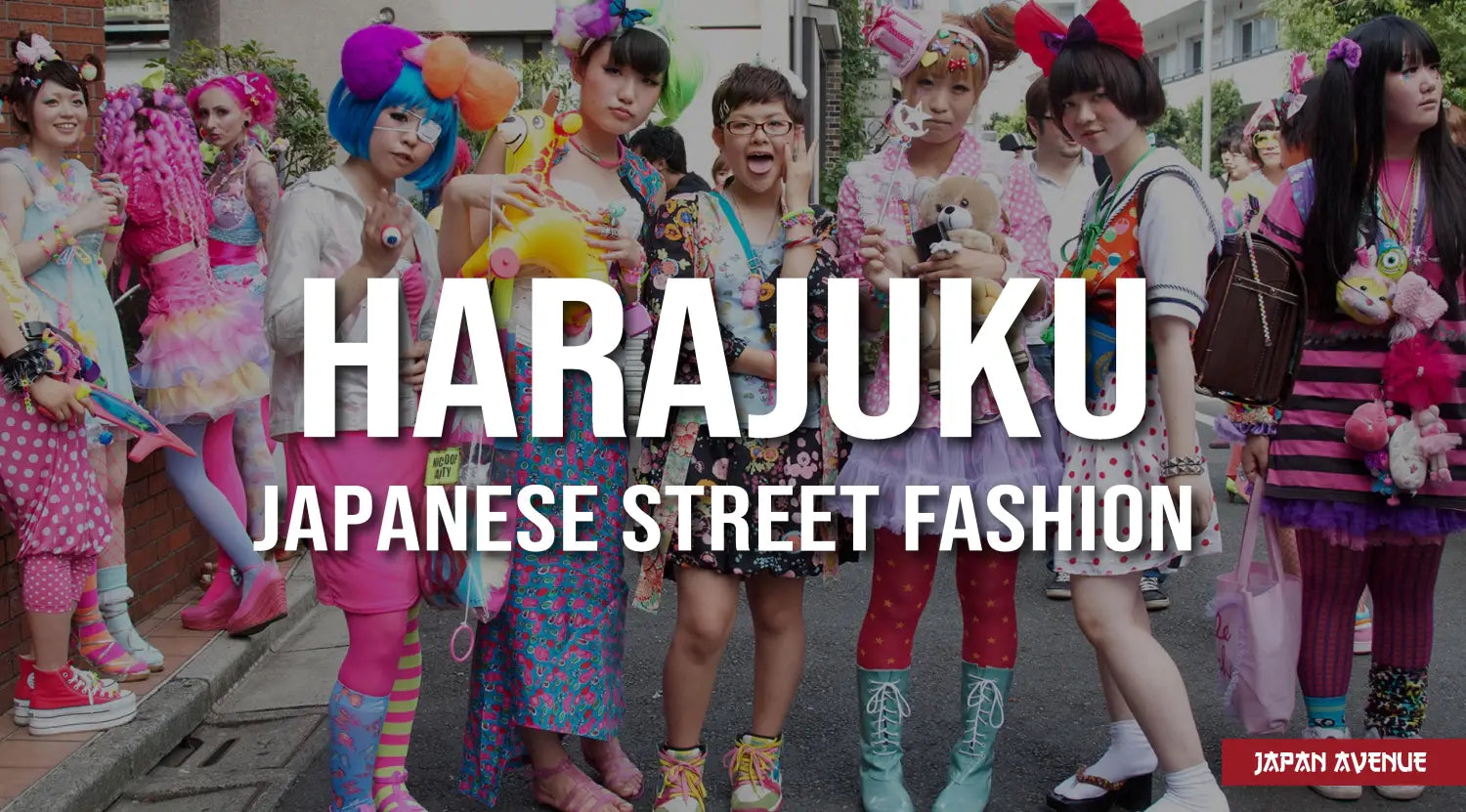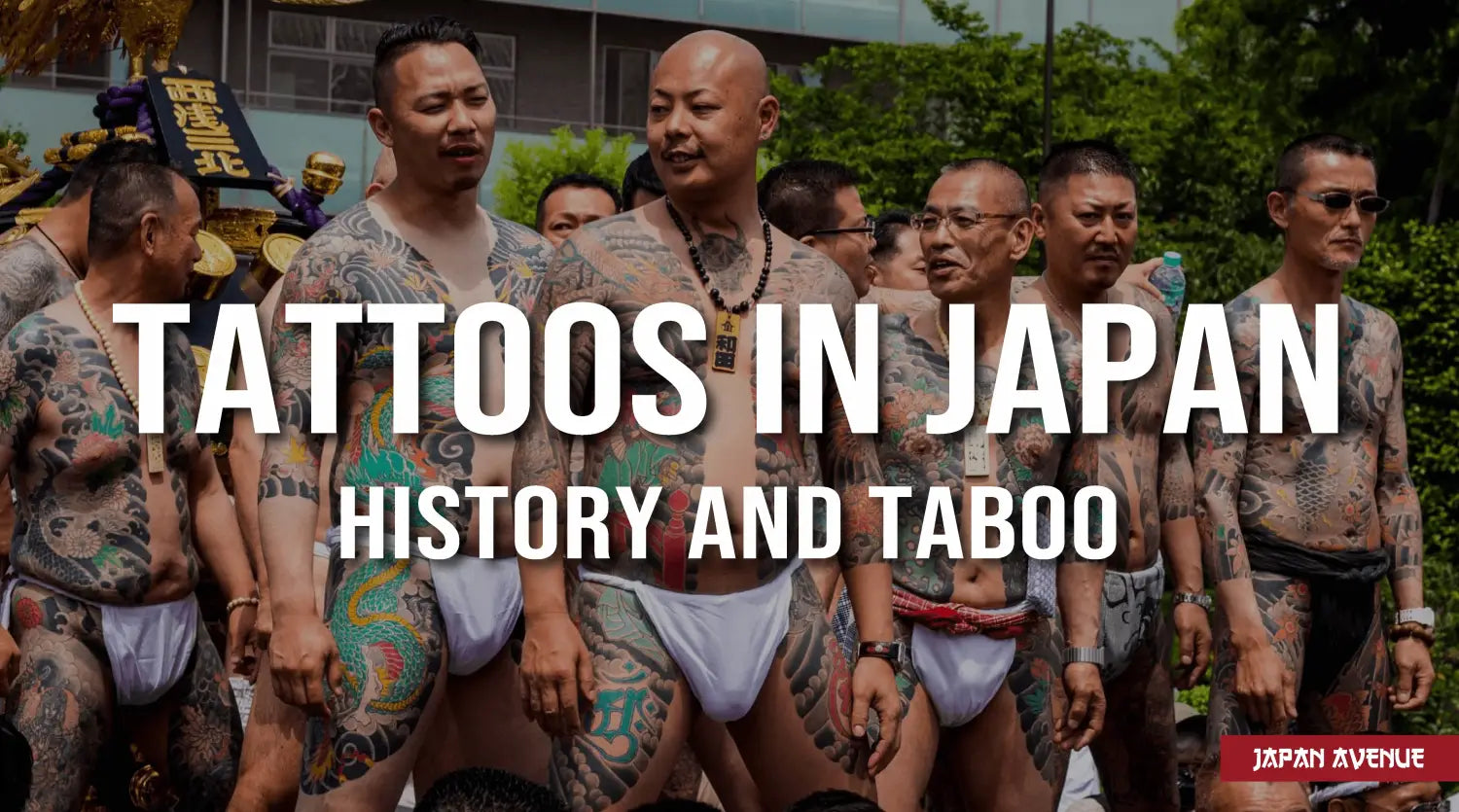Born in the early 1980s, the Harajuku fashion style gathers dozens of different styles, each one more eccentric than the other. It was only in the 2000s that this fashion appeared in the West.
The Harajuku style - or Japanese street fashion - owes its title to the district with the same name, located in the district of Shibuya in Tokyo. In the 1970s, the Harajuku district became the temple of fashion, rock and avant-garde.
Ready to dive into this completely crazy universe of Japanese fashion? 😃
Harajuku fashion: the origins and codes
More than just a simple fashion story, the Harajuku style is part of a movement of protest against the strict rules of Japanese society and the imposition of conformity. Every weekend, hundreds of young people invade the fashion district, changing the mandatory uniform of the week for colorful and extravagant outfits.
Originally, the trend was to mix traditional Japanese clothes with modern western clothes. Over the years, many different styles appeared and trends followed one another, but the spirit of Harajuku remains the same: wearing the clothes you like by letting your imagination run free, without worrying about what others may think. A true desire to break with the traditional Japanese fashion which was way too codified.

Harajuku fashion doesn't really follow any guideline, each person is free to wear what he/she wants without worrying about whether the look meets any standards. Even if this fashion is assimilated to teenagers, there is no age limit.
The concept is simple: choose what you like and create a style that reflects your personality. Feel free to layer clothes, mix colors, accumulate japanese accessories and mix traditional and modern. It's all about personal expression.
As mentioned before, the Harajuku style includes many different styles: Sweet Lolita, Gothic Lolita, Decora, Ganguro, Visual kei...
In this article, we will focus on the most common Japanese street fashion styles, through pictures. Do not forget, the aim is to feel good in your clothes, so be sure to mix and match several trends and styles in order to create your own 😉
The Lolita style, a kawaii universe
The Lolita style is widely inspired by 17th century fashion and the Rococo and Baroque movements. This elegant and refined style originated in a "soft" protest movement against the strict rules of society in the late 1970s.
At the beginning, there were two distinct trends: the Sweet Lolitas and the Gothic Lolitas.
The first ones wear pastel colors, puffy skirts, lace and frills. Their make-up is light and flirty and their hair is simple but elegant.
The seconds wear dark clothes with touches of red or purple, as well as accessories and motifs belonging to the gothic universe (cross, skull...). The dresses remain puffy and feminine but the make-up is more accentuated.
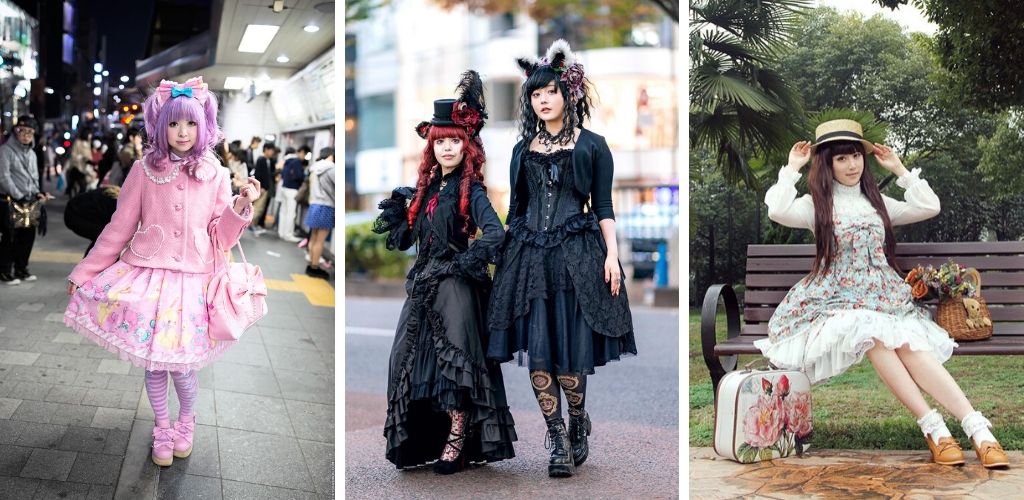
Over the years, new sub-styles have appeared, but the purpose remains the same: look like a little doll.
Thus, we find the Fruits Lolitas that like to wear very colorful clothes with fruity patterns, the Country Lolita that wears country dresses or the Wa Lolita that revisits traditional Japanese clothes.
In a completely opposite universe, there are also the Guro Lolita (or Horror Lolitas) who seem to come straight out of a horror movie. Their fetish outfits often consist of a sexy nurse's blouse covered in blood.
👉 Interested in this kawaii fashion? Check out our complete guide for adopting the Lolita style (Online Soon)!
The Decora style, extravagance above all!
More recently than the Lolita style, the Decora style is easily recognizable by its accumulation of accessories: hair clips, glasses, rings, bracelets, necklaces, fake nails and stickers...
This very extravagant style is all about acid colors, the layering of clothing and plush bags.
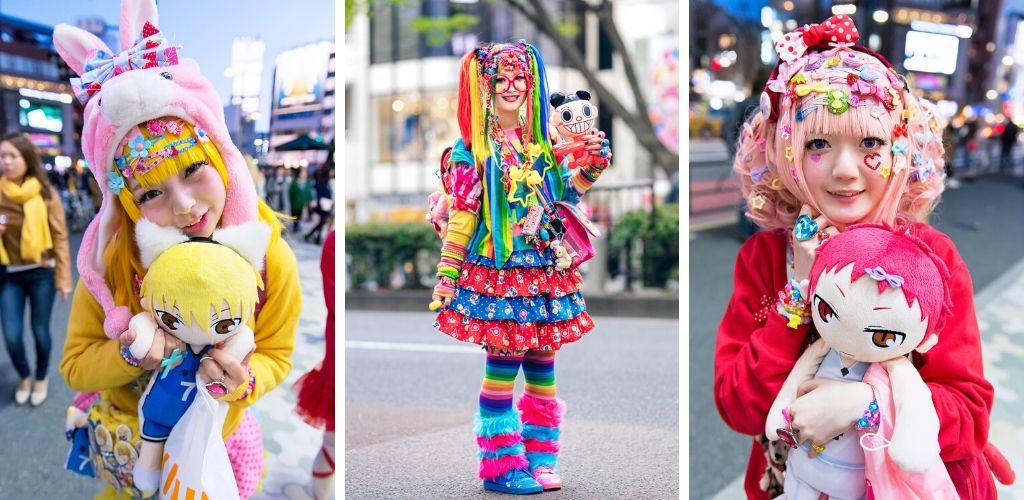
There are no specific rules for adopting the Decora style, although it is best to keep one dominant color for the entire outfit (otherwise it will be a little too eye-popping). This fashion became popular partly thanks to the queen of pop, Kyary Pamyu Pamyu.
Cosplay fashion, a passion in Japan
A shortened form of the expression "Costume Playing", the word Cosplay refers to dressing up as a manga or anime character. It's not just about putting on a costume, it's also about embodying the character by adopting his or her body expression and attitude.
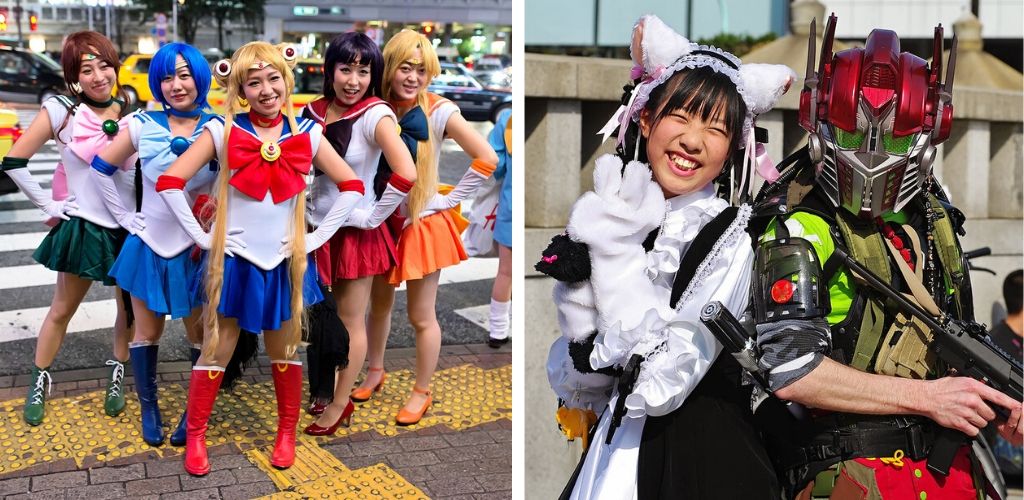
In Japan, Cosplay is not just a hobby that is indulged once a year, such as during a festival, but a true clothing fashion.
If you happen to walk in the streets of Harajuku district during a weekend, you will surely encounter people dressed up as Sangoku, Naruto or other fictional characters. Cosplay fashion is taken very seriously, the costume must be true to the character and the make-up and accessories must not be neglected.
👉 To learn more, check out our article dedicated to the Cosplay craze in Japan!
The Gyaru style, the rebel bling-bling fashion
The term Gyaru comes from the English word "gal" which means a girl, a babe, a chick.... This word was first used in the 70's to designate Japanese "fashion" teenagers who were rebelling against the traditional Japanese beauty standards.
Inspired by Western culture, the Gyaru style reached its peak in the early 2000s. Nowadays, many sub-styles are derived from this rebellious, glamorous and extravagant fashion.
The basic principle remains the same for all of these styles: tanned skin, bleached hair, colorful and sexy western clothes, a lot of make-up and fancy items (wigs, jewels, false nails...).

Among the Gyaru, there are the Ganguro who have UV-cured skin and long blond bleached hair. The term Ganguro literally means "black face". In the eyes of Japanese adults, this fashion is a real provocation to the traditional beauty of Japanese women: pale skin and black hair. This rebellious fashion phenomenon aims to shock and free oneself from the constraints of an overly conventional Japanese society.
The Yamanba, Manba and Banba styles are all derivatives of the Ganguro style. In addition to a highly tanned skin, Manba girls show a very imposing make-up. On top of a layer of dark foundation, the girls enlarge their eyes by drawing large white circles around the eyes and add a pair of contact lenses, often blue. To complete the look, they apply a white lipstick and some colored gummies under the eyes. On the clothing side, flashy colors are a must!
Nowadays, these styles are no longer particularly trendy (and maybe that's for the best 😅).
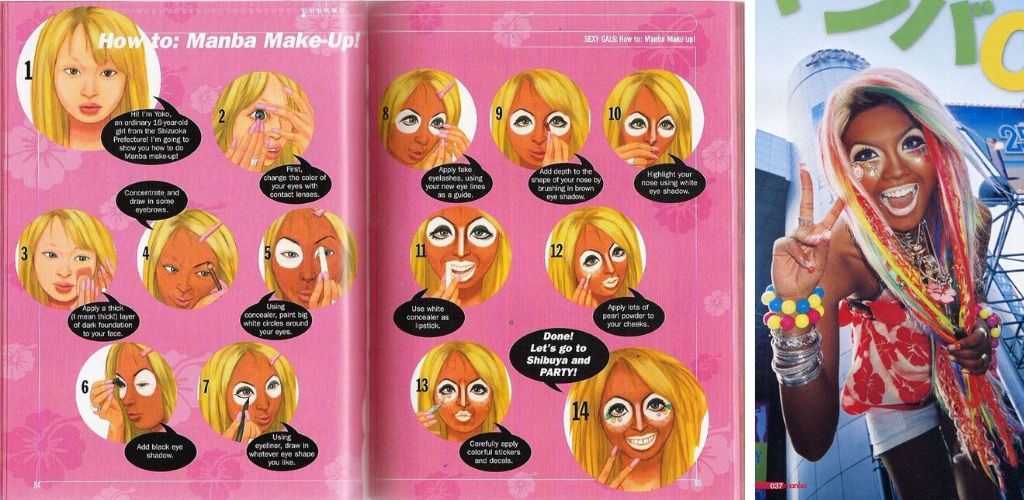
Kogaru (or Kogal) are particularly fond of short, sexy clothing inspired by the school uniform. The "ko" in Kogaru stands for Kokosei which means "high school". Of course, the hair is once again bleached and the skin is artificially tanned.
There are many sub-styles of Gyaru, each with a particular influence. For example, the Bosozoku style features a biker look and favors black clothes, leather and chains. The B-Gyaru style is inspired by R&B with braided hair and sportswear. The Himegyaru style is the princess version of Gyaru. And so on...
Mori Kei style, a return to nature
The Mori Kei style, or Mori Girl, is far from the artificial bling and flashy colors of the Gyaru fashion style.
Literally, Mori Kei means "forest girl". This new fashion appeared in 2006-2007. Fans of this fashion favor all that is natural, organic and "homemade". Their make-up is very light and their hairstyle simple.

The natural side is found both in the materials (linen, cotton, leather, wool ...) and in the colors (brown, beige, green, blue gray ...). Regarding the outfit, dresses and skirts are often long with a superposition of clothes, big wool sweaters, shawls or hand-knitted ponchos. The Mori Kei style is a lovely mix between the Scandinavian style and the boho look.
The Visual Kei style, a very strong visual identity
Visual Kei appeared in the 80s and reached its peak in the first half of the 90s. The term visual kei can be translated as "visual genre" and defines both a music and a clothing style.
What they have in common? A very strong visual identity. A Visual Kei band may play rock, metal or rap music, as long as they give as much importance to their look (outfit, makeup and hair) and their stage performances. The group X Japan is among the founders of this artistic movement.

The characteristics of the Visual Kei clothing style are: Punk inspired dark or colored clothes, extravagant hairstyles with often bleached or colored hair and a general androgynous look. It is frequently mistakenly confused with the Emo style. Visual Kei fashion is particularly popular with fans from Europe and America.
Which Harajuku style suits you?
After this small overview on the different clothing styles born amidst the Harajuku district (the list is far from being exhaustive!), maybe you feel like trying one of them, either on a daily basis or just for a night out 😉 ?
Are you melting with love in front of a little fur baby? Do you love designing your own clothes and doing creative activities? You love candies and the adult world does not inspire you? No doubt, the kawaii universe is your thing and the Lolita style will fit you perfectly.
You love to draw attention to yourself by wearing flashy colors? You have an incredible collection of all kinds of accessories? Are you fascinated by the world of Kyary Pamyu Pamyu? How about trying to adopt the Decora style? Start small with some colorful layered clothing, hair clips and a plush bag.
Nature is your element? Do you like to eat organic and local? For you, the perfect Sunday is a flea market and a walk in the woods? Do you feel comfortable in loose fitting clothes? In that case, the Mori kei style is for you.
Let us know in the comments which Harajuku style is made for you and make sure to check on our japanese clothing for women ! 😃
Image source: tokyofashion.com

